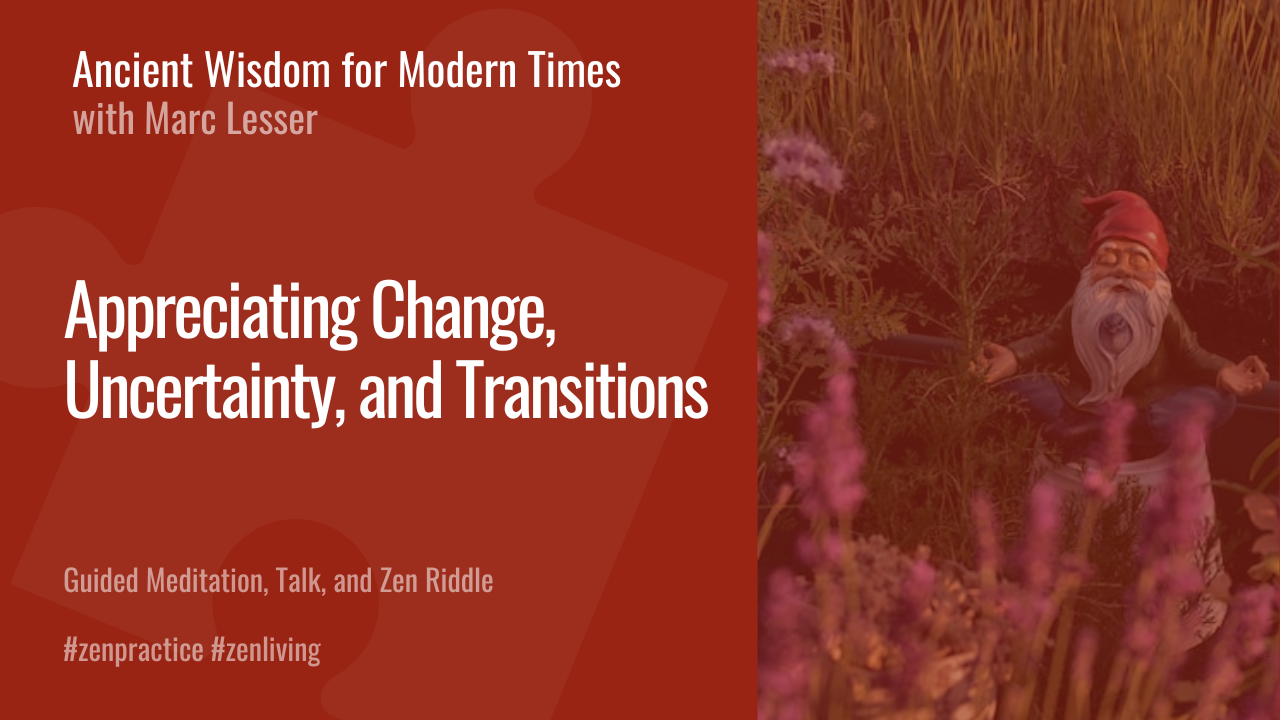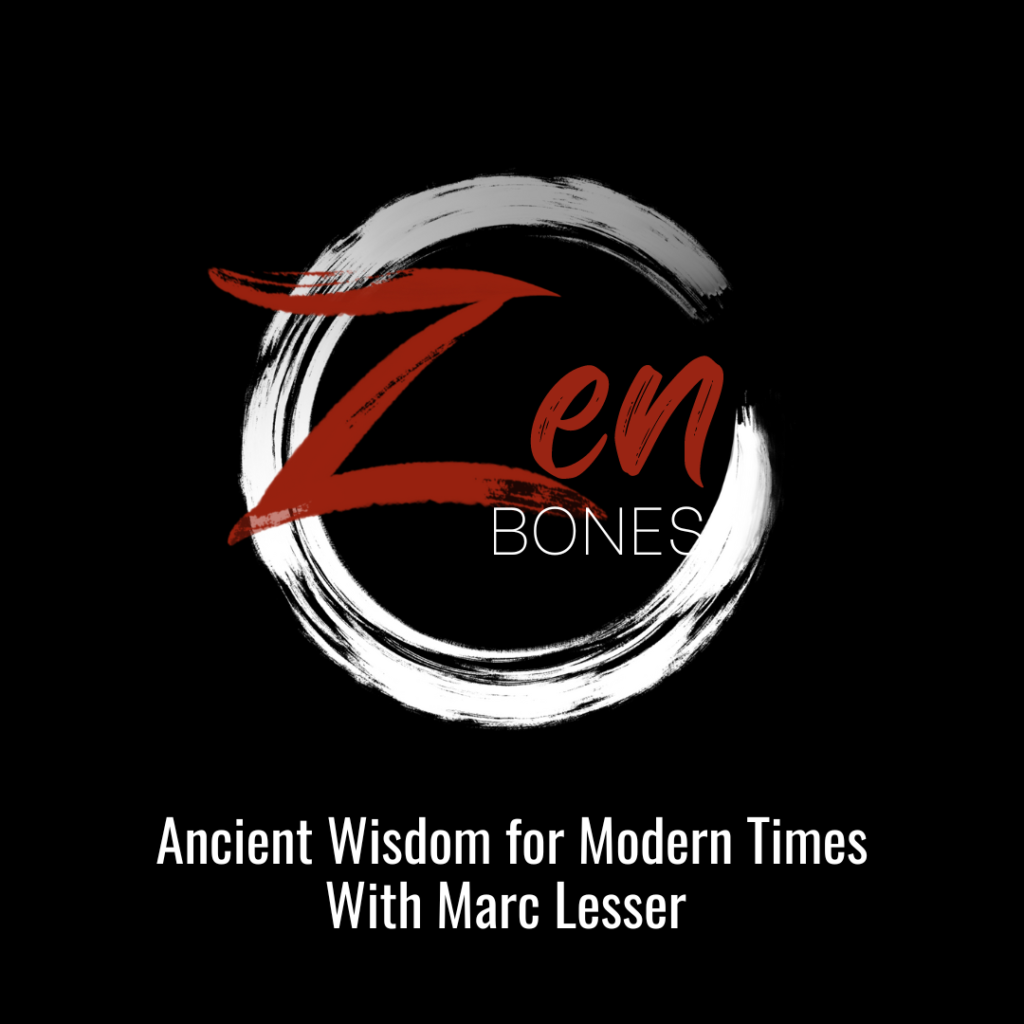In this practice episode Marc talks about working with change, uncertainty, and transition. He unpacks the teachings of Zen teacher Dongshan who describes 3 strategies for working more skillfully with change: the bird path, the mysterious way, and the open hand. — leaving no trace, appreciating the unknown, and living with an open hand instead of a closed fist.
Today’s Zen puzzler is about control, and letting go of control as a path to finding greater ease and freedom.
EPISODE TRANSCRIPT
Marc: Welcome to Zen Bones. This is Marc Lesser. Zen Bones is a biweekly podcast that features conversations with leading spiritual teachers and activists. It’s an exploration of how Zen teachings and practices can inform and support your everyday life.
Please support our work by making a donation @marclesser.net, M-A-R-C-L-E-S-S-E-R.net. It would be most appreciated. Thank you.
[music]
In today’s practice episode, I talk about working with change, uncertainty, and transitions. I unpack the teachings of Zen teacher, Dongshan, who describes three practices. He calls them The Bird Path, The Mysterious Way, and the Open Hand.
Leaving no trace, appreciating the unknown, and living with an open hand instead of a closed fist. Today’s zen puzzler is about control and letting go of control as a path to finding greater ease and freedom. I hope you enjoy today’s episode.
[music]
Let’s begin today with a short meditation, a short sitting together. Yes, just stopping, pausing. Noticing what it’s like to be here. Bringing some awareness to the body and to the breath. Breathing in and breathing out.
Breathing in. I am aware that I’m breathing in and breathing out. I am aware that I’m breathing out.
This is one of the earliest teachings of the historical Buddha where he says this is the path to finding freedom. Just awareness. Awareness of the breath, awareness of the body, awareness of our thinking, and awareness of the deep connections and patterns of consciousness and of life and keeping it simple.
Just being here. No other place than here. No other time than right now. Feeling the flow of the breath and letting go of our usual to-do lists and judgments and just opening the mind and the heart. Allowing our minds and bodies to function fully without resistance or without anything extra.
Letting go of doing anything extra. Just being here. Feeling the simplicity and the beauty of being alive. Nothing to get or change or improve. Allowing big mind to arise and letting small mind drop away as much as possible.
Big mind, right? The mind that cuts through our usual judgments, criticisms, sense of lacking. Nothing lacking right now. Please feel free to continue sitting. Or you can join me as I continue on this journey. I’m going to ring the bell.
[music]
I want to talk today about appreciating change and uncertainty. Certainly, we are living in a time of tremendous uncertainty, tremendous lack of clarity, and seems even heightened by the pace of change, and the questions about how can we find our own sense of ease in the midst of the challenges of our daily lives, of making a living, of caring for ourselves and for our families.
Finding equanimity and freedom in the midst of uncertainty is a core important practice in the world of Zen.
Again, I think of Zen as a code word for being fully human or for self-actualization and helping others. Finding freedom as a means to benefit everyone, especially the benefit and influence of the people that we love, the people we live with, the people we work with.
I’m often coming back to different Zen teachers for some guidance on how to find more sense of freedom, equanimity in the midst of change and uncertainty, and transitions.
One of my favorite teachers is Dongshan, who’s one of the greatest Zen teachers of all time, who lived in 9th-century China, which was known as the golden age of Zen. He taught what he called three ways of navigating change. These were the Bird Path, the Mysterious Way, and the Open Hand.
I suspect that even during the 9th century in China, there was great, great uncertainty. I think it’s part of how we humans live and exist in the midst of great challenges and drama, emphasizing the need for the bird path, the mysterious way, and the open path.
The bird path, he describes, as the practice of leaving no trace in the midst of activity. It’s like the opposite of a leader or a person who leaves great emotional wakes. The people who seem to live and create stress or anger or feelings of lack of equanimity, feelings of lack and scarcity.
The bird path means communicating with clarity, with conviction, with connection, and with love. For our work, for ourselves, for the people that we influence and are influenced by. It’s about communicating without creating confusion, without anything extra or anything missing.
This bird path starts by noticing and being aware of your emotions. When we feel impatient, explore this feeling, this emotion. When feeling impatient, it’s easy to blame, to communicate dissatisfaction, to put others down.
The bird’s path is to turn these feelings like impatience into a sense of awareness, into care. Recognizing a need to make changes, to shift, to be more clear. This bird path is challenging. It requires, I think, some aspiration to practice.
On a deeper level, this practice, I think, goes beyond clear communication. It’s the practice of being so comfortable in our own skins that we widen our perspective. That includes caring for others. That includes an embodiment of selflessness.
The bird path is a way of acting, more full functioning, cultivating an unhindered body and mind like a bird soaring effortlessly and effectively.
The second practice that Dongshan recommends is the mysterious way. This involves appreciating how much we don’t actually know and finding comfort in this not knowing. At its heart, this is a powerful way to develop greater comfort and effectiveness, right in the midst of change and uncertainty, a skill that we all need right now.
Practicing and embracing the mystery allows us to find our way with more ease and greater confidence, even when there aren’t the usual road signs or patterns to rely on. We’re often making lots of decisions throughout our day in our business lives, in our personal lives, without knowing what will happen.
We weave together the stories to make decisions. We live our lives to make things as explainable as possible. Underneath, we know there is tremendous uncertainty, that the world is mysterious, and that fish swim in the sea, the sun rises and sets.
We start businesses and work collaboratively with people, and things change, and things change. This practice of the mysterious way reminds me one of my books, Seven Practices of a Mindful Leader. Practice number three is, don’t be an expert.
That none of us are experts in the realm of relationships, human emotions, consciousness. This is part of the mysterious way. When we appreciate the mystery in these realms, we can be more adventurous, learn to thrive, live with gusto right in the midst of not knowing.
The third of Dongshan’s practice is what he calls the open hand. This is a simple and powerful practice. It’s the opposite of working and living with a closed fist. I’ve noticed that many people often, without even realizing it, have their fists closed, their minds and hearts closed, working, living, approaching things with a sense of scarcity, avoiding stress and uncertainty.
This practice of the open hand involves noticing. It means noticing when our fists are closed, noticing our own clinging and rigidity, and having the skill and courage to open your hand to yourself, to others. Opening your heart and your mind.
The practice of the open hand means seeing your work and your life as an offering. Responding generously to needs and problems. Cultivating an attitude of care and service. How do we work with these practices?
One way is to bring to mind current challenges, situations at work or at home where something needs to be changed.
Then to consider how you might integrate and work with these three approaches. You might do some journaling or just talk to someone about what does the bird path look like? What does it mean to leave no trace in the midst of working with these challenges?
How might you use your energy more like a clean bonfire than a bonfire as Zen teacher Shunryu Suzuki says? Then second, you might write down and list the ways in which you can find ease and confidence right in the midst of uncertainty, right in the midst of the mystery of how things happen. Noticing causes and conditions, being aware of outcomes, but appreciating the mystery.
The third practice is, again, bringing awareness to any time you’re showing up with a closed fist. Noticing and opening your hand. You might even literally close your hand and make a fist, and then slowly open it. Noticing how does it feel when your hand is closed in a fist? How does it feel when you’re opening?
I want to end with a short poem by Naomi Shihab Nye that expresses, I think, this spirit of this Dongshan teaching about working with uncertainty. The poem is called Burning The Old Year.
Letters swallow themselves in seconds. Notes, friends tied to the doorknob. Transparent scarlet paper sizzle-like moth wings, marry the air. So much of any year is flammable, lists of vegetables, partial poems, orange swirling flame of days.
So little is a stone. Where there is something and suddenly isn’t, an absence shouts, celebrates, leaves a space. I begin again with the smallest numbers. Quick dance, shuffle of losses, and leaves. Only the things I didn’t do crackle after the blazing dies.
Where there is something and suddenly there isn’t an absence. Shouts, celebrates, leaves a space. I begin again with the smallest numbers. Quick dance, shuffle of losses, and leaves. Only the things I didn’t do crackle after the blazing dies.
Speaker 2: Welcome to the Zen Bone puzzler where I will regularly be presenting a story or a Zen cone or a poem, something to contemplate, to think about. A story that has purpose. It’s about developing greater insight and reflection. Not so much for a solution, but as a way to support your practice, a meditation in daily life.
I want to introduce today’s Zen puzzler. This is one of my favorite parts of having done and doing this Zen Bones podcast is introducing some lightheartedness and humor. I’m always happy to talk about the Zen puzzler.
To take an expression or poem or thought from the traditional or non-traditional Zen expression and see how we might apply it to our everyday lives, to our relationships, to our work. Today’s Zen puzzler is an expression from Shunryu Suzuki in Zen Mind, Beginner’s Mind that I come back to.
Where he says, “The best way to control your sheep or your cow is to give it a wide pasture. The best way to control your sheep or your cow is to give it a wide pasture.” Interesting. This is much like what I was talking about in terms of how to work with uncertainty and change and transition.
We generally want more control. Of course, sometimes we need to control, sometimes we need boundaries to set clear boundaries. There is often the right place in time for a certain amount of control. Here, he’s suggesting this paradox of controlling by letting go of our usual sense of control and instead creating a wide pasture.
This might even start with ourselves. Instead of trying to control our own thinking, what if we open our– create a wide pasture for our own thinking to have the courage and trust to see what happens?
This is also, I think he’s mostly here talking about in our important relationships with our loved ones, with family, with people we work with, when we have a sense of discomfort and wanting to control, to try creating a wider pasture. Giving people more space.
I think in this talk he says, “It’s important to pay attention. It’s important to really, really pay attention to what happens when we try to control. What happens when we move from trying to control others to giving a wider pasture? That we express and give our care and our attention and our hearts, but letting go of trying to control in the usual way.”
This is the Zen puzzler. The best way to control your sheep or a cow is to give them a wide pasture. See how that might go for you. Maybe try practicing with it this week. Thank you very much
[music]
I hope you’ve appreciated today’s episode. To learn more about my work and my new book, Finding Clarity, you can visit my website, marclesser.net, M-A-R-C-L-E-S-S-E-R.net. This podcast is offered freely and at the same time, it relies on the financial support from listeners like you. Thank you very much.
[music]
[00:24:50] [END OF AUDIO]









